If you are looking for a place to enjoy the wonders of the night sky, look no further than Cherry Springs State Park in Pennsylvania.
Cherry Springs is one of the best places for stargazing in the United States and easily the best on the East Coast.
In this guide, you will learn everything you need about Cherry Springs State Park stargazing, from its history and location to its facilities and programs. You will also find some tips and tricks to make your visit a memorable and enjoyable experience.
In this article, you get to
Experience the beauty of the stars at Cherry Springs State Park, a renowned dark sky preserve.
Learn about the park’s history, including its establishment by the Civilian Conservation Corps (CCC) in 1936.
Explore the unique features that make Cherry Springs State Park an ideal location for stargazing, such as its high elevation and dark skies.
Discover the fascinating celestial objects visible at the park, including the Milky Way, planets, moon phases, constellations, nebulae, galaxies, meteors, comets, and aurora borealis.
Participate in astronomy programs, from guided night sky tours to laser-guided constellation tours and star parties.
Understand how to plan your visit effectively by checking weather forecasts, moon phases, and reservation requirements.
Set up and use stargazing equipment properly, whether you choose binoculars, telescopes, or cameras.
Learn about the accessible features and facilities available to visitors with disabilities.
Explore additional recreation activities at the park, such as hiking, biking, fishing, and snowmobiling.
Familiarize yourself with park rules and regulations to ensure a respectful and responsible visit, preserving the natural environment and dark skies for everyone’s enjoyment.
By the end of this article, you’ll be well-prepared to embark on an unforgettable stargazing adventure at Cherry Springs State Park, armed with knowledge about its history, facilities, celestial wonders, programs, and practical tips to make the most of your visit.
Let’s dive right in.
Background on Cherry Springs State Park Stargazing
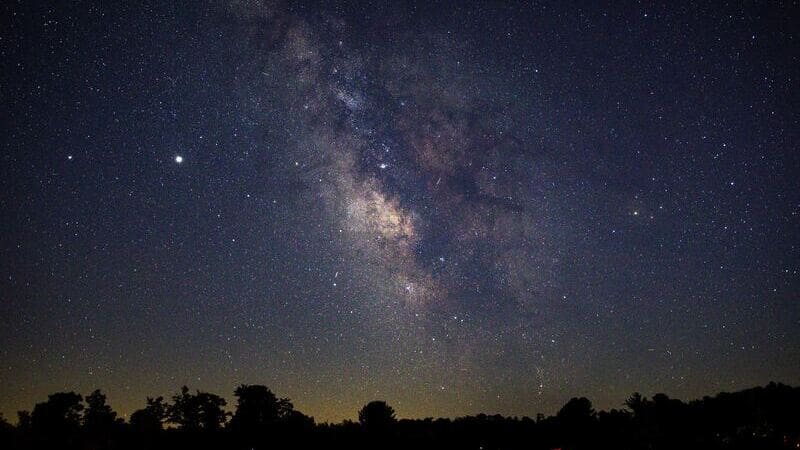
Cherry Springs State Park is an 82-acre park in Potter County, Pennsylvania, within the 262,000-acre Susquehannock State Forest. The park was named after the large stands of black cherry trees that once grew there. The park was established in 1936 as a Civilian Conservation Corps (CCC) project, and some of the original CCC structures remain there.
The park is famous for its exceptionally dark skies, which make it ideal for stargazing and astronomy. The park is on top of a 2,300-foot high mountain, surrounded by forested hills that block out most artificial light from nearby towns and cities.
The park also has low humidity and a high elevation, which reduce the amount of atmospheric interference and enhance the night sky’s clarity.
The park has been recognized as an International Dark Sky Park by the International Dark-Sky Association (IDA). This non-profit organization promotes the preservation and protection of dark skies worldwide.
The park received the Gold Level Dark Sky Park designation in 2008, the highest level awarded by the IDA. The park is one of only 15 Gold Level Dark Sky Parks in the world and the only one in Pennsylvania.
One recommended dark-sky location in the United States is Cherry Springs State Park in Pennsylvania. Known for its Dark Sky Park designation, the park offers exceptional stargazing because of its remote location and minimal light pollution. It provides designated stargazing areas, astronomy programs, and an observatory for public use, making it a prime spot for stargazing enthusiasts.

By Aviad Faruz
CEO, Know Mastery
Stargazing Experience at Cherry Springs

Stargazing at Cherry Springs is a fantastic experience you will never forget. Depending on the weather and the season, you can see a variety of celestial objects and phenomena, such as:
- The Milky Way galaxy stretches across the sky like a river of stars. You can see the bright core of the galaxy, as well as its spiral arms and dark dust lanes.
- The planets of our solar system shine brightly among the stars. You can see Venus (the Evening Star), Mars (the Red Planet), Jupiter (the King of Planets), Saturn (the Ringed Planet), and sometimes Mercury (the Swift Planet) and Uranus (the Ice Giant).
- The moon phases from a thin crescent to a full disk throughout the month. You can see the craters, mountains, valleys, and seas on its surface.
- The sun rises and sets over the horizon. You can see its fiery disk, as well as its spots and flares with special filters.
- The constellations are patterns of stars that have been named after mythological figures, animals, or objects. You can see familiar constellations like Orion (the Hunter), Ursa Major (the Big Bear), Cassiopeia (the Queen), and Scorpius (the Scorpion), as well as less-known ones like Lyra (the Harp), Cygnus (the Swan), and Aquila (the Eagle).
- The nebulae are clouds of gas and dust that glow or reflect light from nearby stars. You can see colorful nebulae like the Orion Nebula (a stellar nursery), Lagoon Nebula (a star-forming region), Ring Nebula (a dying star), and North America Nebula (a continent-shaped cloud).
- The galaxies are collections of billions of stars held together by gravity. You can see distant galaxies like Andromeda Galaxy (our nearest neighbor), Triangulum Galaxy (a spiral galaxy), Sombrero Galaxy (a hat-shaped galaxy), and Whirlpool Galaxy (a galaxy with a companion).
- The meteors are streaks of light caused by small pieces of rock or metal that burn up in the atmosphere. You can see sporadic meteors throughout the year and a specific meteor shower that occurs at certain times of the year. Some of the most famous ones are the Perseid Meteor Shower (in August), Geminids (in December), Leonids (in November), and Lyrids (in April).
- The comets are balls of ice and dust that orbit the sun and develop tails when approaching it. You can see occasional comets that become visible to the naked eye, such as Hale-Bopp (in 1997), McNaught (in 2007), and Neowise (in 2020).
- The aurora borealis are curtains of green, red, blue, or purple light that dance in the sky. They are caused by charged particles from the sun that interact with the Earth’s magnetic field. You can see them occasionally at Cherry Springs, especially during periods of high solar activity.
These are just some amazing sights you can see at Cherry Springs. You can also see satellites, space stations, artificial satellites, zodiacal light, airglow, and more. The sky is full of wonders that await your discovery.
FREE STARGAZING CHECKLIST
My 5-page Stargazing Checklist will enhance your astronomical observations.
Follow this free checklist to navigate the night sky with confidence, clarity, and a sense of preparedness for a rewarding stargazing experience.

Astronomy Programs
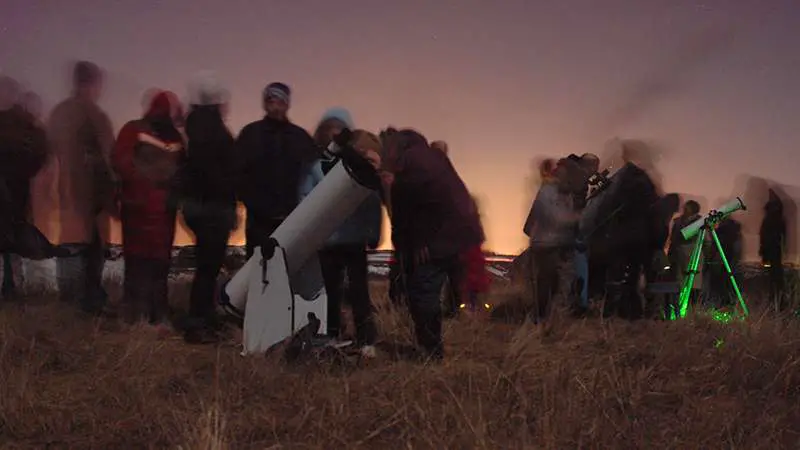
If you want to be a stargazer and learn more about the night sky and astronomy, you can join one of the many programs that are offered by the park staff and volunteers. These programs are designed to educate and entertain visitors of all ages and backgrounds.
Some of the programs are:
- Night Sky Tours: These are guided tours of the night sky that are held on Friday and Saturday nights from April to October. You can use binoculars, telescopes, or your own eyes to explore the stars, planets, constellations, and more. You can also ask questions and get answers from knowledgeable astronomers.
- Laser-Guided Constellation Tours: These tours use a powerful green laser pointer to highlight and explain the constellations and their stories. You can learn about the mythology, history, and science behind the star patterns. These tours are held on Friday and Saturday nights from April to October.
- Star Parties: A Cherry Springs Star Party is a unique event that brings together amateur and professional astronomers nationwide. You can see hundreds of telescopes set up on the observation field and observe various celestial objects. You can also attend lectures, workshops, demonstrations, and contests. These events are held twice a year, in June and September.
- Solar Viewing: These sessions allow you to observe the sun and its features safely. You can use special filters and equipment to see the sunspots, flares, prominences, and more. You can also learn about the sun’s structure, cycle, and impact on our planet. These sessions are held on Saturday afternoons from April to October.
- Astronomy Talks: These are presentations that cover various topics related to astronomy and space exploration. You can learn about the latest discoveries, missions, theories, and challenges in astronomy. You can also interact with experts and enthusiasts who share their passion and knowledge. These talks are held on Saturday evenings from April to October.
These programs are free and open to the public, but some require registration or reservation in advance. You can check the park’s website or call the office for more information and schedules.
Observation Sites
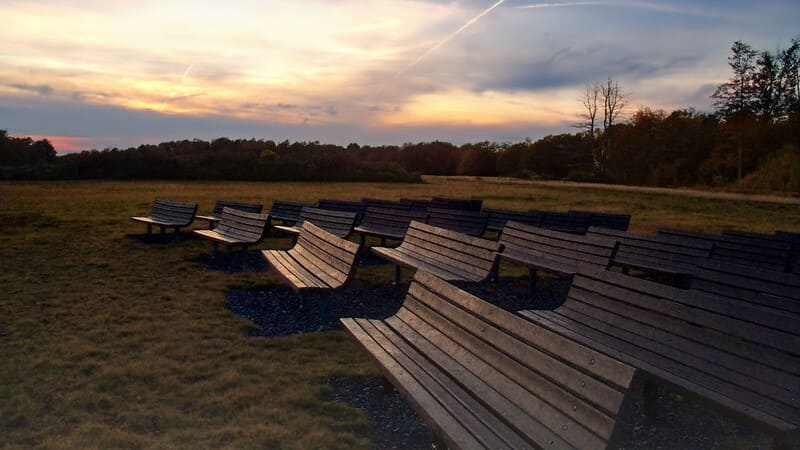
There are three areas in the park that are available for stargazing: the Night Sky Public Viewing Area, the Overnight Astronomy Observation Field, and the Rustic Campground.
Night Sky Public Viewing Area
The Night Sky Public Viewing Area is north of Route 44 (opposite the Overnight Astronomy Observation Field).
This area is best for short-term stargazing for a few hours. Although white light is permitted in this area, it is recommended to use a red filter or cover for your flashlight to preserve your night vision. You can follow the walkway to the benches. There is a backlit summer sky map on this pathway. Pets are prohibited in this area.
Overnight Astronomy Observation Field
The Overnight Astronomy Observation Field is located south of Route 44 (next to the park office).
This area is excellent for overnight stargazing for serious astronomers with equipment. All lights must have red filters or be fully shielded in this area. White light is prohibited in this area. This area offers an excellent 360-degree view of the night sky with minimal obstructions. Pets are not permitted in this area.
Rustic Campground
The Rustic Campground is east of Route 44 (behind the park office).
This area is suggested for overnight stargazing for casual stargazers without equipment. There are no lighting restrictions in this area, but it is recommended to use red filters on all lights and keep campfires as small as possible. This area has 30 campsites with picnic tables and fire rings.
Pets are allowed in this area.
Planning Your Visit
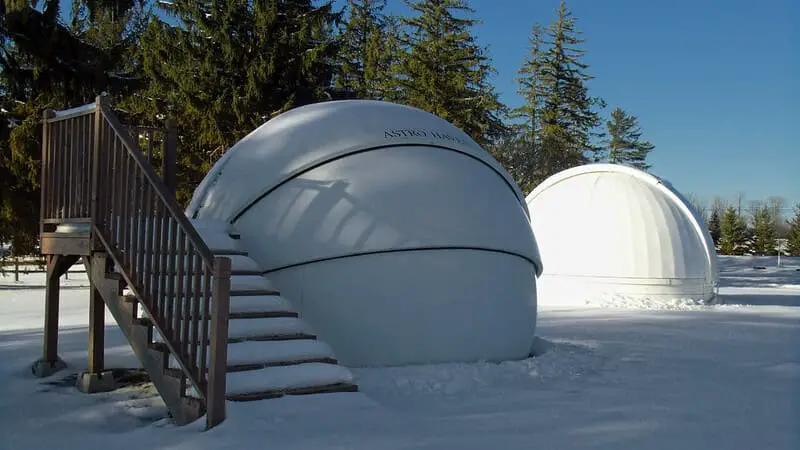
If you are planning to visit Cherry Springs State Park for stargazing, there are some things you need to consider and prepare before you go. Here are some tips and suggestions to help you plan your visit:
- Check the weather forecast and the moon phase. The best time to visit the park is when the sky is clear, and the moon is new or thin. You can use the Clear Sky Chart or the Dark Sky Finder to determine the park’s sky conditions and light pollution levels.
- Make a reservation or register for your observation site. If you want to use the Overnight Astronomy Observation Field, you must make a reservation online or by phone. The fee is $15 per night per vehicle. Register at the park office upon arrival if you want to use the Night Sky Public Viewing Area. There is no fee for this area, but space is limited. If you want to use the Rustic Campground, you must make a reservation online or by phone. The fee is $15 per night per site.
- Pack your equipment and supplies. Depending on your observation site and your stargazing preferences, you may need to bring different types of equipment and supplies. Some of the items you may need are binoculars, a telescope, a tripod, a camera, a star chart, a red flashlight, batteries, a power cord, an extension cord, power inverter, laptop, software, books, magazines, chair, table, blanket, sleeping bag, tent, food, water, cooler, stove, matches, firewood, etc.
- Arrive early and set up your site. You should arrive at the park before sunset and set up your site before it gets dark. This will help you avoid disturbing other stargazers and prevent accidents or injuries. You can also use this time to familiarize yourself with the park facilities and rules.
- Enjoy your stargazing experience and respect others. Once the sun sets and the stars come out, you can start your stargazing adventure and explore the wonders of the night sky. You can also join one of the astronomy programs or interact with other stargazers. However, please be respectful of others and follow the park etiquette and regulations. Do not use white light or make loud noises in the observation areas. Do not touch or move other people’s equipment without permission. Do not litter or damage the park property or natural resources.
Set Up and Equipment

If you want to enhance your stargazing experience at Cherry Springs State Park, use some equipment that can help you see more details and capture more images of the night sky. However, choosing and using the right equipment can be challenging and confusing for beginners or even experienced stargazers.
Here are some tips and suggestions to help you set up and use your equipment:
Choose Equipment
Choose your equipment according to your budget and goals. Many types of equipment can be used for stargazing, such as binoculars, telescopes, cameras, tripods, etc. Each type has its own advantages and disadvantages, as well as different costs and features. You must decide what equipment suits your budget and goals best.
For example, if you want to see wide sky views with minimal hassle and expense, you may opt for binoculars. You may opt for a telescope if you want to see more details of specific objects with more control and customization. If you’re going to capture images of the sky with more flexibility and creativity, you may opt for a camera.
Use Your Equipment
Once you have chosen your equipment, you must learn how to use it properly and safely.
You need to read the manuals and instructions with your equipment carefully and follow them accordingly. It would be best if you also practiced using your equipment before you go to the park so that you can familiarize yourself with its functions and settings. You also need to take care of your equipment by cleaning it regularly and storing it securely
Align Your Equipment
Align your equipment with the sky coordinates. One of the most essential steps in setting up your equipment is aligning it with the sky coordinates. This will help you find and track the objects you want to see or photograph in the sky.
Two main sky coordinate systems are used for stargazing: the altitude-azimuth system and the equatorial system.
The altitude-azimuth system uses the horizon and the cardinal directions as reference points and measures the position of an object by its altitude (angle above the horizon) and azimuth (angle along the horizon).
The equatorial system uses the celestial equator and the celestial poles as reference points and measures the position of an object by its right ascension (angle along the celestial equator) and declination (angle above or below the celestial equator).
Depending on the type of your equipment, you may need to use one or both systems to align your equipment. You can use a compass, a level, a star chart, or software to help you with the alignment process
Focus
After aligning your equipment with the sky coordinates, you need to focus your equipment on the object of interest. This will help you see or photograph the object with more clarity and sharpness.
Depending on the type of your equipment, you may need to use different methods to focus your equipment.
For example, if you use binoculars, you may need to adjust the eyepieces and the center wheel until you see a clear image. If you are using a telescope, you may need to adjust the eyepiece and the focus knob until you see a clear image. If you are using a camera, you may need to adjust the lens and the focus mode until you see a clear image
Adjustments
The final step in setting up your equipment is adjusting your equipment settings according to the sky conditions. This will help you see or photograph the object with more contrast and brightness. Depending on the type of your equipment, you may need to use different settings to adjust your equipment.
For example, if you are using binoculars, you may need to choose a pair with a large aperture (the diameter of the front lens) and a low magnification (the ratio of the focal length of the eyepiece to that of the objective lens) to see more light and more field of view.
If you are using a telescope, choose an eyepiece with a high magnification and a low focal ratio (the ratio of the focal length of the objective lens to that of the eyepiece) to see more details and magnification.
If you are using a camera, you may need to choose a lens with a large aperture (the ratio of the focal length of the lens to that of its diameter) and a low focal length (the distance from the lens to its focal point) to see more light and more field of view. You may also need to adjust other settings, such as exposure time, ISO sensitivity, white balance, etc.
Park Rules and Regulations
As a visitor of Cherry Springs State Park, you are expected to follow some rules and regulations that are designed to protect and preserve the park’s natural resources and dark skies, as well as ensure your safety and enjoyment.
Some of these rules and regulations are:
- Obey all posted signs and directions from park staff and volunteers.
- Do not enter or use any areas or facilities that are closed or restricted.
- Do not collect or disturb any plants, animals, rocks, fossils, or artifacts.
- Do not feed or approach any wildlife.
- Do not introduce or release any non-native species.
- Do not start or spread fires except in designated fire rings or stoves.
- Do not leave any fires unattended or burn any trash or hazardous materials.
- Do not smoke in any buildings or observation areas.
- Do not litter or dump any waste or sewage.
- Do not use any fireworks, firearms, or explosives.
- Do not use any drones, kites, balloons, or lasers.
- Do not use any generators, radios, speakers, or musical instruments.
- Do not use any white light or flashlights in observation areas. Use a red light.
- Do not make any excessive noise or disturb other visitors.
- Do not bring any alcoholic beverages or illegal substances.
- Do not camp or park in any unauthorized areas.
- Do not exceed the speed limit or drive off-road.
- Do not bring any pets in observation areas.
- Keep your pets on a leash and under control at all times.
- Please clean up after your pets and dispose of their waste properly.
You may be subject to fines, penalties, or expulsion from the park if you violate these rules and regulations. You may also be liable for any damages or injuries that you cause. Please respect the park’s resources and dark skies, and enjoy your stargazing experience responsibly.
Recreation Activities
Besides star gazing, Cherry Springs State Park also offers a variety of recreational activities that you can enjoy during the day or night.
Some of these activities are:
- Hiking: The park has several trails that range from easy to moderate in difficulty and length. You can hike through the forest, meadows, streams, and hills and see different plants and animals. Some of the trails are Cherry Springs Trail (1-mile loop), Dark Hollow Trail (1.5 miles one way), Fisherman’s Path (0.5 mile one way), and Susquehannock Trail System (85 miles loop).
- Biking: The park allows biking on the paved roads and some of the trails. You can bike along the scenic Route 44, which passes through the park and connects to other state parks and forests. You can also bike on some of the trails that are shared with hikers, such as Dark Hollow Trail and Fisherman’s Path. You need to bring your own bike and helmet and follow the traffic rules and trail etiquette.
- Fishing: The park has two streams that offer fishing opportunities for trout and other fish. You can fish at Cherry Springs Creek, which flows through the park and is stocked with brook trout by the Pennsylvania Fish and Boat Commission. You can also fish at Lyman Run, located near the park and a designated wild trout stream. You must have a valid Pennsylvania fishing license and follow the fishing regulations.
- Hunting: The park allows hunting for deer, bear, turkey, squirrel, and other game during the designated seasons. You can hunt on the parkland and the adjacent state forest land, which offer a variety of habitats and terrains. You must have a valid Pennsylvania hunting license and follow the hunting regulations.
- Picnicking: The park has a picnic area near the park office and the Rustic Campground. The picnic area has 20 picnic tables, two charcoal grills, two water spigots, two vault toilets, and a pavilion accommodating up to 50 people. The pavilion can be reserved for a fee by calling the park office. The picnic area is open from sunrise to sunset.
- Snowmobiling: The park allows snowmobiling on some trails with enough snow cover (at least 6 inches). You can snowmobile on Cherry Springs Trail, Dark Hollow Trail, Fisherman’s Path, and Susquehannock Trail System. You need to bring your own snowmobile and helmet and follow the snowmobiling regulations.
These are just some recreational activities you can enjoy at Cherry Springs State Park. You can also enjoy other activities such as birdwatching, wildlife viewing, photography, geocaching, and more. You can check the park’s website or call the office for more information and schedules.
Lodging and Amenities
If you plan to stay overnight at Cherry Springs State Park, you have several options for lodging and amenities.
Some of these options are:
- Rustic Campground: The park has a rustic campground open from April to October. The campground has 30 campsites that accommodate tents, trailers, or RVs. Each site has a picnic table and a fire ring. The campground has two water spigots, vault toilets, and a dump station. There are no electric hookups or showers. The campground fee is $15 per night per site. You need to make a reservation online or by phone.
- Overnight Astronomy Observation Field: The park has an overnight astronomy observation field open year-round. The field can accommodate up to 35 vehicles with tents or small trailers. Each vehicle has a designated parking spot and a 16-by-16-foot grassy area. The field has two water spigots, two vault toilets, and a pavilion with electrical outlets. There are no showers or dump stations. The field fee is $15 per night per vehicle. You need to make a reservation online or by phone.
- Cabins: The park has two available for rent from April to October. The cabins are located near the park office and the Rustic Campground. Each cabin can accommodate up to six people and has two bedrooms, a living room, a kitchen, a bathroom, and a porch. The cabins have electric heat, lights, outlets, refrigerators, stoves, microwaves, toasters, coffee makers, dishes, utensils, pots, pans, etc. The cabins do not have air conditioning, TV, phone, or internet. You need to bring your own bedding, towels, toiletries, etc. The cabin fee is $75 per night per cabin. You need to make a reservation online or by phone.
- Hotels: If you prefer more comfort and convenience, you can stay at one of the nearby hotels within a 30-minute drive from the park. Some of the hotels are Frosty Hollow Bed and Breakfast (9 miles), Sweden Valley Hotel and Cabins (11 miles), Penn Wells Hotel (14 miles), Microtel Inn and Suites (15 miles), etc. You need to check the availability and rates of these hotels online or by phone.
These are just some of the options for lodging and amenities at Cherry Springs State Park. You can also find other options, such as motels, cottages, campgrounds, etc., in the surrounding area. You can check the park’s website or call the office for more information and recommendations.
Accessible Features and Facilities
Cherry Springs State Park is committed to providing accessible features and facilities for visitors with disabilities.
Some of these features and facilities are:
- Accessible parking spaces at the park office, the Night Sky Public Viewing Area, the Overnight Astronomy Observation Field, the Rustic Campground, and the picnic area.
- Accessible restrooms at the park office and the picnic area.
- Accessible campsites at the Rustic Campground.
- Accessible cabins with ramps, grab bars, roll-in showers, etc.
- Accessible trails with hard-packed surfaces and gentle slopes.
- Accessible observation platforms with railings and benches.
- Accessible telescopes with eyepieces at different heights.
- Accessible programs with audio devices, large-print materials, sign language interpreters, etc.
If you need any assistance or accommodation during your visit to Cherry Springs State Park, please get in touch with the park office in advance or upon arrival.
Frequently Asked Questions
Here are some of the frequently asked questions about Cherry Springs State Park stargazing:
What is the best time of year for stargazing in Cherry Springs State Park?
The best time of year for stargazing in Cherry Springs State Park is from late spring to early fall (May to October). During this time of year, the weather is usually clear and mild, the nights are long and dark, and the sky is full of interesting objects and events. However, you can also stargaze at other times of year if you don’t mind the cold or snow.
Can I see the Milky Way from Cherry Springs State Park?
Yes, you can see the Milky Way from Cherry Springs State Park on any clear night when the moon is not too bright or too high in the sky. The Milky Way is visible from April to November, but the best months to see it are June, July, and August. During these months, you can see the bright core of the galaxy, as well as its spiral arms and dark dust lanes. You can also see many stars, clusters, nebulae, and galaxies that are part of the Milky Way. The Milky Way is one of the most spectacular sights at Cherry Springs State Park.
Can you go to Cherry Springs State Park at night?
Yes, you can go to Cherry Springs State Park at night, but you must follow some rules and regulations. The park is open 24 hours a day, but the office is open from 8 a.m. to 4 p.m., Monday to Friday. Register at the park office upon arrival if you want to use the Night Sky Public Viewing Area. If you want to use the Overnight Astronomy Observation Field or the Rustic Campground, you must make a reservation online or by phone.
What other activities are available near Cherry Springs State Park?
You have many options if you want to explore other activities near Cherry Springs State Park, including other stargazing spots in Pennsylvania.
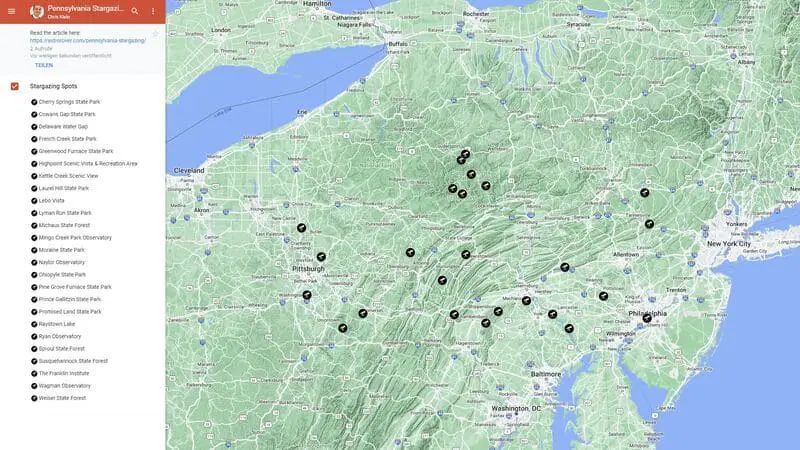
Some of these options are:
- Visit other state parks and forests that are close to Cherry Springs State Park, such as Lyman Run State Park (4 miles), Patterson State Park (9 miles), Denton Hill State Park (10 miles), Ole Bull State Park (12 miles), etc. These parks and forests offer more recreational activities such as swimming, boating, fishing, hunting, skiing, snowshoeing, etc.
- Visit other attractions and landmarks that are near Cherry Springs State Park, such as the Pennsylvania Lumber Museum (8 miles), Coudersport Ice Mine (10 miles), Potter County Historical Society Museum (14 miles), Austin Dam Memorial Park (18 miles), etc. These attractions and landmarks offer more educational and cultural experiences, such as learning about the region’s history, industry, and heritage.
- Visit other towns and cities that are near Cherry Springs State Park, such as Galeton (9 miles), Coudersport (14 miles), Wellsboro (32 miles), Bradford (50 miles), etc. These towns and cities offer more shopping and dining options, such as local shops, restaurants, cafes, bars, etc.
These are just some of the activities available near Cherry Springs State Park. You can also find other activities, such as golfing, horseback riding, rafting, etc., in the surrounding area.
Is it possible to see the Northern Lights from Cherry Springs State Park?
Yes, it is possible to see the Northern Lights from Cherry Springs State Park, but it is very rare and unpredictable.
The Northern Lights are also known as aurora borealis, which are curtains of green, red, blue, or purple light that dance in the sky. They are caused by charged particles from the sun that interact with the Earth’s magnetic field. The Northern Lights are usually seen in high latitudes near the poles, but sometimes, they can be seen in lower latitudes when there is a strong solar storm or a geomagnetic disturbance. The Northern Lights are faint and can be easily washed out by moonlight or light pollution.
Therefore, to see them from Cherry Springs State Park, you must have a clear and dark night with a high solar activity and a low moon phase. You also need to check the Aurora forecast and alerts online or by phone before you go to the park.
Summary: Stargazing at Cherry Springs
Thank you for reading my article about Cherry Springs State Park stargazing.
Stargazing at this International Dark Sky Association’s official Dark Sky Park is a wonderful activity that you can enjoy with your family, friends, or yourself. You can see many amazing sights in the night sky that will awe and inspire you.
You can also learn more about astronomy and space exploration through various programs and resources. You can also enjoy other recreational activities during the day or night at the park or nearby areas. You can also find different options for lodging and amenities that suit your needs and preferences. You need to plan your visit carefully and follow some rules and regulations that ensure your safety and enjoyment.
I hope you will visit the park soon and have a memorable and enjoyable experience as an astronomer for a night (or more).
Happy Stargazing!
You may also enjoy reading other articles from my Dark Sky Parks series for stargazing at other National Parks:
- Acadia
- Anza-Borrego Desert State Park
- Arches National Park
- Big Bend
- Bryce Canyon
- Capulin Volcano
- Copper Breaks
- Cosmic Campground
- Death Valley
- Enchanted Rock
- Grand Canyon
- Great Basin
- Joshua Tree
- Haleakala
- Massacre Rim
- Olympic National Park
- Oracle State Park
- Red Rock Canyon
- Rocky Mountain National Park
- Tonopah Stargazing Park
- Yellowstone National Park
- Zion




